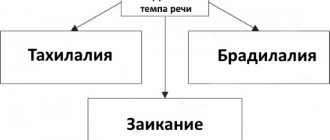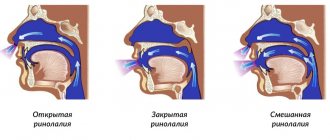General underdevelopment of speech, or GSD, is a systemic disorder of speech activity in which its semantic and sound components - phonetics, vocabulary and grammar - are incorrectly formed.
Until the age of 3–4 years, children “have the right” to speak as they can and want. But if your son or daughter, even after reaching this age, does not fully use speech as a means of communication, you should consult a doctor - a neurologist or speech therapist. If there is a problem, it is better to diagnose it in preschool age and teach the child to speak correctly. Otherwise, in the future, OPD promises him big problems in social and personal terms: difficulties in mastering writing and reading, the school curriculum as a whole, retardation in mental and mental development, personality disorders.
What does OHP mean and its symptoms?
Here are general signs that may indicate underdevelopment of speech in a child:
- said the first words at 3–4 years old, and in more severe cases at 5 years old;
- speaks illiterately, incoherently and incomprehensibly, the phonetic design of speech is low;
- The baby understands the words addressed to him, but cannot fully express his thoughts.
Depending on the severity of OHP, it is divided into 4 levels.
Level 1 violation is the most severe. The child either does not speak at all or speaks individual sounds or syllables.
With a level 2 illness, the baby, although he speaks at an everyday level, is illiterate, pronounces sounds incorrectly, and his vocabulary is small.
With speech underdevelopment of the 3rd level, the child has developed phrasal speech, but there is lexico-grammatical and phonetic underdevelopment.
The easiest is level 4. The baby communicates fully verbally, but there are still some problems.
Next, we’ll talk about the characteristics of each level of OHP in children in more detail.
When to see a speech therapist
There are several conditions under which you need to seek help from a specialist.
- There is no humming or babbling.
- By two years, the vocabulary is completely undeveloped or the child does not speak at all.
- Does not pronounce simple sounds or replaces them (“k” with “t”, etc.).
- If by the age of three the baby speaks a language that only he understands.
- The child understands everything, reacts to everything, but does not speak.
- If at 4-5 years old speech is slurred, many sounds are not pronounced.
- If after the age of five the child continues to speak softly (“kisya”).
- By the age of six, individual sounds are not pronounced correctly.
- Speaks with hesitation, repeats syllables, stutters.
- A child over 6 years old cannot learn a poem or retell what he heard.
The way a child talks speaks volumes about his mental health. And if there are any hints of deviations from the norm, it is best to contact a specialist. He will tell you whether it is possible to straighten your speech at home or whether you need classes with a doctor. If correct speech is not formed by the age of seven, problems with learning and communication may arise, which will reduce the child’s quality of life in the future.
Degrees of speech underdevelopment and their characteristics
Depending on the depth of the lesion, OHP can manifest itself in different ways - from minor deviations to complete absence of speech.
Level 1: speech is practically absent
You don’t need to be a doctor to notice problems with speech development in a child. He uses babble, sounds, the first syllables of words. He speaks his “own” language; one word can mean several things.
Instead of words, the baby actively expresses his thoughts and desires with gestures and facial expressions, and is always appropriate and correct.
The child does not speak in simple sentences; at best, he uses two amorphous words, for example, “woof bee-bee” - the dog is driving a car.
The passive vocabulary is well developed - the baby understands speech addressed to him. But the active vocabulary is poor, phonemic hearing is not developed - the child cannot pronounce words that consist of several syllables, and says them in his own way: “abas” instead of “bus,” for example.
Level 2: presence of commonly used words
This is the main characteristic of speech underdevelopment of this degree. There are words in speech, although there are not very many of them and the child pronounces them incorrectly. But a grammatical connection between words is already beginning to form.
The kid distorts the name of a certain object, and everywhere. For example, instead of “apple” he says “lyabako”.
The child does not know the shapes, parts of objects, and cannot combine them into groups (dishes, toys, clothes).
The baby pronounces most sounds incorrectly, does not coordinate words in simple sentences, often misses prepositions, and shortens words of several syllables.
But in simple sentences he can correctly name objects and their actions in the plural (for example, goes - go). If you ask your baby to tell you what he sees in the picture, he may come up with a coherent story, albeit a very limited one.
Level 3: violation of grammar and phonetics
The child has a large active vocabulary; he speaks in detailed sentences, but the development of the grammatical and phonemic components of speech suffers.
Parents understand the baby well, but when communicating with others they need a “translator”. The baby pronounces isolated sounds well, but his speech is still unclear. If it is difficult for him to pronounce a sound, he replaces it with an easier one. This is especially true for affricates, whistling, sonorant and hissing sounds.
Complex and complex sentences still cause difficulties, but the child is confidently moving towards success. But little-used vocabulary is still inaccessible to him - in his speech he uses words of everyday meaning that he constantly hears around.
The child constructs phrases and can compose a story, although he still forms sentences with errors. But errors in word agreement do not occur all the time. More often, the child makes mistakes when coordinating nouns and numerals: “many cats - many cats.”
He does not always pronounce complex words correctly; he cannot name words that begin with a specific letter.
Level 4: practically a variant of the norm
Speech underdevelopment is not noticeable, but taken together the symptoms make it difficult for the child to study at school - it is more difficult for him to learn to write and read. Therefore, it is imperative to eliminate the symptoms of OHP. Although this form of disorder is quite rare.
The child periodically pronounces complex words incorrectly - skips syllables, replaces or swaps sounds.
Articulation and diction suffer - speech is unclear, slightly slurred, and the child does not always use words as intended, because he does not understand or confuses their meanings. This is especially true for the characteristics of objects (for example, tall - long, low - short).
Another problem area is the formation of words using a suffix; errors remain in the agreement of nouns and adjectives and the plural.
Critical thinking is developed: if a child is given two answer options, he will choose the correct one.
Parents' mistakes
Often it is the inattention of parents that leads to disturbances in the child’s speech. The main mistakes that are made in the family:
- Lack of help for the baby. Parents do not pay attention to communication.
- Adults “lisp”, distorting speech, giving the child the wrong role models.
The child remembers that his parents like his soft, childish pronunciation and is in no hurry to get rid of it, thus receiving love.
- Ignoring developmental delays.
- Reluctance to correct speech (including your own, for example, pronunciation defects, haste).
- Poor speech experience in a child. The baby is simply not taught to talk, and it is difficult for him to communicate, he does not know how to do this.
- Parents are tired and not ready to talk; it is easier for them to provide their child with a computer or phone with games.
- Adults read little to children.
Reasons for the development of OHP in children
Speech development disorders can have different causes. Let's highlight the following groups:
- Intrauterine development. Infections in the mother during pregnancy, toxicosis;
- Complicated childbirth. Injuries during childbirth, various pathologies;
- Health status of the newborn. Diseases of the central nervous system and traumatic brain injury in infancy can also cause the development of OHP;
- Social factors. Unfavorable family environment. For example, parents did not work with the baby, did not teach, did not develop.
In some cases, OHP in children develops against the background of intellectual or hearing impairments.
What influences the proper development of speech?
There are two groups of factors that influence speech development:
- Biological.
- Social.
The first include various pathogenic factors that can harm proper development: complex intrauterine development, brain infections and injuries, hearing impairment, heredity.
The second group is a combination of the child’s internal development processes and external conditions that are specific to each age stage. For example, the early separation of a baby from his mother sometimes causes emotional instability, impulsiveness, and behavioral disturbances. And this, in turn, leads to speech disorders.
Good conversation is influenced by examples and role models. The child first hears how they speak in the family, so he begins to try it himself. In order to correctly assimilate words during play activities, the child first accumulates impressions - this is the basis for future images and connections with them in speech. The development of gross motor skills also affects the correctness of conversation. The development of speech skills is influenced by the language a child learns to speak. An attempt to master several languages at once may slightly slow down a child’s development; his speech may develop more slowly.
In no case should a child be punished for mistakes in speech, teased or corrected with irritation. This can cause withdrawal and reluctance to try further.
The role of the family in the formation of speech reserve is key. Parents study poems and songs, recitations with their child, teach the child to speak at the right speed, and respond to his attempts to carry on a conversation.
Proper speech development is promoted by:
- Emotionally positive environment;
- Peace of mind in the family;
- Moderate sound communication between loved ones (no shouting);
- Feeling of security in the family;
- Patience of parents towards the child;
- Sensitive and friendly behavior of kindergarten teachers.
Comprehensive diagnosis of the disease
It is important to involve different specialists in diagnosing speech underdevelopment. This is necessary to identify the cause of the disease. After all, it is important to treat it, and not the symptoms.
First of all, a neurologist, speech therapist, and neuropsychologist look at the baby. In some cases, you may need to consult a surgeon, dentist, otolaryngologist, or psychoneurologist.
But the leading role is given to the neurological examination. The doctor will assess the state of the nervous system and the location of the lesion - the form of the speech disorder depends on it. In conclusion, the neurologist indicates the cause of the disorder, its form, and focuses attention on the primary problem areas. All this data is subsequently used in diagnosis and correction by a speech therapist.
After consulting a neurologist - and in some cases other specialized specialists - the child is referred to a speech pathologist-speech pathologist. He studies the conclusions of his colleagues, supplements the anamnesis with the words of the parents, and then examines the child’s speech apparatus, studying the features of his sound pronunciation.
Then the speech therapist communicates with the little patient. In the process of communication, he assesses the degree of development of the child’s speech: whether he can express thoughts coherently, speak meaningfully, and competently construct a story.
Based on the examination, the speech therapist determines the form and degree of OHP and plans treatment.
How is dysarthria diagnosed and treated?
Before starting treatment, it is necessary to identify the problem. Examination of children with dysarthria is aimed at classifying the defect taking into account symptomatology, severity of the disease, and localization of the lesion.
In neurological practice, the most common topical classification of dysarthria, according to which the following forms are distinguished:
- Subcortical (extrapyramidal) dysarthria. Develops due to damage to the subcortical nerve nodes.
- Pseudobulbar dysarthria in children. The most common diagnosis. This form can be spastic and paretic.
- Cerebellar dysarthria. Develops when the cerebellum is damaged; it practically does not occur in children.
- Bulbar dysarthria in children. Occurs when the ganglia of the cranial nerves, which are concentrated in the medulla oblongata, are damaged. It is quite rare.
- Cortical dysarthria. Not recognized by all researchers in children, it develops due to focal changes in the motor cortical areas.
In addition to the form, during diagnosis, specialists determine the severity of symptoms - the degree of dysarthria in children. The mildest form is considered to be erased speech dysarthria in children; it is characterized by imprecise articulatory movements, mild disorders of phonetics and auditory perception. Moderate lesions are characterized by multiple and pronounced defects in sound pronunciation, a quiet nasal voice, and incomprehensible speech. Finally, the most severe form is anarthria, which is characterized by slurred speech or its complete absence.
The examination of a small patient, in addition to consultation with a specialist and special speech therapy tests, includes MRI, EEG, electromyography, transchannel magnetic stimulation, and electroneurography.
Correction of general speech underdevelopment
The correction program depends on the cause of the disease. For example, if OHP has developed against the background of dysarthria, you first need to eliminate problems that are associated with the innervation of the speech apparatus; for sensory alalia - to develop phonemic hearing.
In any case, treatment is carried out in a complex manner. In case of speech underdevelopment of levels 1–2, a speech therapist and a neuropsychologist or neurologist work with a small patient.
Doctors carry out correctional work in several directions at once:
- Develop imitative activity. The baby repeats sounds that he heard earlier;
- Train hand motor skills. The development of speech also depends on the dexterity of small hands. Specialists conduct classes with the baby that develop coordination of speech with movement, general and fine motor skills;
- They train the articulatory apparatus - the muscles of the lips, tongue, cheeks. This is facilitated by speech therapy exercises, articulation and breathing exercises.
The program also includes exercises for memory training and development of speech understanding. The goals of the lessons depend on the degree of impairment.
Correction of OHP in children of the 1st level
The goal is to teach the child to understand speech addressed to him, to activate the baby’s independent speech activity, memory, thinking and attention. The grammatical component of speech is important. But the phonetic design does not matter yet.
Correction of level 2 violation
The goal is to develop speech activity in the baby, teach him to understand speech, teach phrasal speech, and work on sound pronunciation (sounds that the child pronounces incorrectly or does not speak at all).
In case of ODD in children of 1st - 2nd degree, education is possible only in specialized schools for children with severe speech development disorders.
Correction of level 3 violation
The goal is to develop coherent speech in the child, improve its lexical and grammatical components, and consolidate the correct pronunciation of sounds and phonemic perception. At this stage, it is important to prepare the baby to master literacy. Children with this diagnosis study in correctional classes at a regular school.
Correction of level 4 violation
The goal is to bring the child’s speech to the age norm so that he does not have problems with learning at school. The speech therapist pays attention to improving and consolidating correct sound pronunciation, lexico-grammatical and phonemic components of speech. The speech therapist develops developed phrasal speech and grapho-motor skills, and also teaches the child the basics of writing and reading. Children with speech impairments of the 4th degree study in regular classes.
In addition to speech therapy work, a neurologist can prescribe drug therapy, transcranial magnetic stimulation, massage, and treatment with an osteopath.
Primary speech therapy examination
Let us describe how the initial examination of the OHP is carried out. First, the speech therapist gets acquainted with the notes of the child neurologist and pediatrician. Clarifies the features of the course of early speech development.
Then he diagnoses oral speech and determines the degree of formation of the language system. Studies the state of coherent speech: composing a story from a picture, retelling.
Examines the correctness of word formation, coordination of parts of speech and sentence construction. Determines the vocabulary and ability of children to correctly name objects or phenomena.
Studies the sound side of speech: the structure and motor skills of the speech apparatus, sound pronunciation, syllable structure and sound content of words. Determines abilities for phonemic perception, sound analysis and synthesis. Conducts diagnostics of auditory-verbal memory and other mental processes.
The conclusion helps to determine suitable correction techniques
The result of the examination is a speech therapy report. It reflects the level of speech development and the clinical form of speech disorder.
For example: level 2 OHP in a child with a motor form of alalia.
The diagnosis after “ONR” must necessarily indicate what clinical diagnosis is causing the speech underdevelopment. The conclusion helps determine appropriate corrective techniques.






